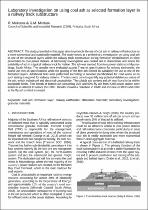 ResearchSpace
ResearchSpace
Laboratory investigation on using coal ash as selected formation layer in a railway track substructure
JavaScript is disabled for your browser. Some features of this site may not work without it.
- ResearchSpace
- →
- Research Publications/Outputs
- →
- Conference Publications
- →
- View Item
| dc.contributor.author |
Mokoena, Refiloe

|
|
| dc.contributor.author |
Mvelase, Gculisile M

|
|
| dc.date.accessioned | 2020-07-16T10:12:20Z | |
| dc.date.available | 2020-07-16T10:12:20Z | |
| dc.date.issued | 2019-10 | |
| dc.identifier.citation | Mokoena, R. and Mvelase, G.M. 2019. Laboratory investigation on using coal ash as selected formation layer in a railway track substructure. Proceedings of the 7th African Young Geotechnical Engineers Conference, 5-6 October 2019, Cape Town, p. 291-296 | en_US |
| dc.identifier.isbn | 978-0-6398403-0-7 | |
| dc.identifier.uri | https://drive.google.com/file/d/1dVkVV8LvN8EVWyBk0EdhojZxohg0gfgf/view | |
| dc.identifier.uri | http://hdl.handle.net/10204/11485 | |
| dc.description | Paper delivered during the 7th African Young Geotechnical Engineers Conference, 5-6 October 2019, Cape Town | en_US |
| dc.description.abstract | The study presented in this paper aims to promote the use of coal ash in railway infrastructure as a more economical and sustainable material. The study serves as a preliminary investigation on using coal ash as one of the structural layers within the railway track substructure during formation rehabilitations in close proximities to coal power stations. A laboratory investigation was carried out to characterise and assess the suitability of ash in a typical railway track formation. The ash was sourced from two power stations in Mpumalanga, South Africa. The samples were evaluated against Transnet specifications for railway earthworks, the coarse ash met all specifications while the grading of the fine ash limited its suitability for use as one of the formation layers. Additional tests were performed according to national specifications for road works as no such testing is required for railway material. The tests were done to quantify any potential deleterious nature of the ash, which include pH and electrical conductivity. The soluble salt content and pH was found to be within acceptable limits. Two blends of bottom ash containing 25% and 50% fly ash from Kriel power station were tested in an attempt to reduce the OMC. Results showed a reduction in OMC and increase in MDD and CBR as the fly ash content increased. | en_US |
| dc.language.iso | en | en_US |
| dc.publisher | South African Institution of Civil Engineering | en_US |
| dc.relation.ispartofseries | Worklist;23223 | |
| dc.subject | Coal ash | en_US |
| dc.subject | Formation layers | en_US |
| dc.subject | Railway earthworks | en_US |
| dc.subject | Alternative materials | en_US |
| dc.subject | Laboratory investigations | en_US |
| dc.subject | Granular materials | en_US |
| dc.title | Laboratory investigation on using coal ash as selected formation layer in a railway track substructure | en_US |
| dc.type | Conference Presentation | en_US |
| dc.identifier.apacitation | Mokoena, R., & Mvelase, G. M. (2019). Laboratory investigation on using coal ash as selected formation layer in a railway track substructure. South African Institution of Civil Engineering. http://hdl.handle.net/10204/11485 | en_ZA |
| dc.identifier.chicagocitation | Mokoena, Refiloe, and Gculisile M Mvelase. "Laboratory investigation on using coal ash as selected formation layer in a railway track substructure." (2019): http://hdl.handle.net/10204/11485 | en_ZA |
| dc.identifier.vancouvercitation | Mokoena R, Mvelase GM, Laboratory investigation on using coal ash as selected formation layer in a railway track substructure; South African Institution of Civil Engineering; 2019. http://hdl.handle.net/10204/11485 . | en_ZA |
| dc.identifier.ris | TY - Conference Presentation AU - Mokoena, Refiloe AU - Mvelase, Gculisile M AB - The study presented in this paper aims to promote the use of coal ash in railway infrastructure as a more economical and sustainable material. The study serves as a preliminary investigation on using coal ash as one of the structural layers within the railway track substructure during formation rehabilitations in close proximities to coal power stations. A laboratory investigation was carried out to characterise and assess the suitability of ash in a typical railway track formation. The ash was sourced from two power stations in Mpumalanga, South Africa. The samples were evaluated against Transnet specifications for railway earthworks, the coarse ash met all specifications while the grading of the fine ash limited its suitability for use as one of the formation layers. Additional tests were performed according to national specifications for road works as no such testing is required for railway material. The tests were done to quantify any potential deleterious nature of the ash, which include pH and electrical conductivity. The soluble salt content and pH was found to be within acceptable limits. Two blends of bottom ash containing 25% and 50% fly ash from Kriel power station were tested in an attempt to reduce the OMC. Results showed a reduction in OMC and increase in MDD and CBR as the fly ash content increased. DA - 2019-10 DB - ResearchSpace DP - CSIR KW - Coal ash KW - Formation layers KW - Railway earthworks KW - Alternative materials KW - Laboratory investigations KW - Granular materials LK - https://researchspace.csir.co.za PY - 2019 SM - 978-0-6398403-0-7 T1 - Laboratory investigation on using coal ash as selected formation layer in a railway track substructure TI - Laboratory investigation on using coal ash as selected formation layer in a railway track substructure UR - http://hdl.handle.net/10204/11485 ER - | en_ZA |





